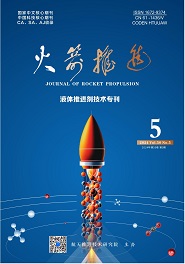航天推进技术研究院主办
LIN Xiaoxiong,TAO Jiasheng,WEN Zheng.Influence of plume deposit of ion thruster on thermal control properties of satellite[J].Journal of Rocket Propulsion,2017,43(02):9-17.
离子推力器羽流沉积对卫星热控影响研究
- Title:
- Influence of plume deposit of ion thruster on thermal control properties of satellite
- 分类号:
- V434-34
- 摘要:
- 离子推力器的羽流是等离子体,等离子体的组成是带电粒子,这与传统的化学推进系统的羽流成分有很大不同,带电粒子有在卫星表面吸附的倾向,会形成羽流沉积污染.这种羽流沉积会改变卫星表面的吸收率和发射率,从而影响卫星的热控性能.为了预测离子推力器的羽流对卫星的热控性能的影响,建立了离子推力器羽流模型.所建模型采用了工程化离子推力器的在卫星上的布局位置和离子推力器的工作参数,模拟了离子推力器的正离子与中和电子束在工程化中分置的实际情况,使模型更为符合实际.通过数值模拟得到了离子、电子、中性粒子的空间分布,电场分布,得到了钼粒子在卫星表面的分布及沉积厚度,比较了模型计算的离子分布与实验获得的离子分布情况,说明了模型分析的正确性,给出了卫星表面热性能的变化及局部区域温升的最大包络可达二十多度的结果.
- Abstract:
- The ion electric thruster plume is plasma that consists of charged particles,which has a tendency to be adsorbed onto satellite surface.The deposition of the plume can change the absorptivity and emissivity of the satellite surface,which has a negative influence on thermal control property of the satellite.In order to predict this influence,a ion thruster plume model was built.The layout position and working parameters of an engineering ion thruster are adopted in the model to simulate the actual conditions of positive ion and electron beam,which makes the model more in accord with reality.The spatial distribution and electric field distribution of ions,electrons and neutral particles,and deposition distribution of molybdenum particles on satellite surface were obtained with numerical simulation.The ion distributions got by simulation calculation and experiment was compared,which validated the correctness of the model analysis.The thermal property of the satellite surface and the maximum envelope of temperature increase in local region of the satellite surface are given in this paper.
参考文献/References:
[1]DAVID J A, ERIC P, DANIEL V, et al. Products from NASA's in-space propulsion technology program applicable to low-cost planetary missions[J]. Acta astro- nautica, 2014(93): 516-523.
[2]胡照, 王敏, 袁俊刚. 国外全电推进卫星平台的发展及启示[J]. 航天器环境工程, 2015, 32(5): 566-570.
[3]周志成, 高军. 全电推进GEO卫星平台发展研究[J]. 航天器工程, 2015, 24(2):1-6.
[4]方杰, 田辉, 蔡国飙. N20单组元微推进系统及其喷管流场的初步研究[J]. 推进技术, 2005, 26(6): 495-498.
[5]操慧珺, 楚豫川, 曹勇, 等. 离子推进器中离子束中和及推进过程的全粒子数值模拟[J]. 高电压技术, 2014, 40(7): 2119-2124.
[6]YUAN H, JOSEPH J W. Electron kinetic characteristics in plasma plumes: fully kinetic simulations[C]//Procee- dings of 53rd AIAA Aerospace Sciences Meeting. Kissimmee, Florida: AIAA, 2015: 1-10.
[7]贾艳辉, 李忠明, 张天平, 等. 栅极系统电子返流对离子推力器寿命影响[J]. 真空与低温, 2012, 18(1): 21-25.
[8]ROY R I S, HASTINGS D E, GATSONIS N A. Nume- rical study of spacecraft contamination and interactions by ion-thruster effluents[J]. Journal of spacecraft and rockets, 1996, 33(4): 535-542.
[9]马伟, 宣益民, 韩玉阁, 等. 长寿命卫星热控涂层性能退化及其对卫星热特征的影响[J]. 宇航学报, 2010, 31(2): 568-572.
[10]张天平, 陈继巍, 李小平, 等. 地面寿命试验中离子推力器表面的溅射沉积量计算[J]. 航天器环境工程, 2011, 28(5):4 36-439.
[11]侯增祺, 胡金刚. 航天器热控制技术-原理及其应用[M]. 北京: 中国科学技术出版社, 2007(1): 368-370.
[12]KEMP R F, LUEDKE E E, HALL D F, et al. Effects of electrostatic rocket material deposited on solar cells [C]//Proceedings of the 9th NASA Electric Propulsion Conference. Washington D C: NASA, 1972: 1-10.
[13]范平, 邵建达, 易葵, 等. 纳米Mo膜的光学特性及最小连续膜厚研究[J]. 中国激光, 2005, 32(7): 977-981.
[14]孙安邦, 毛根旺, 陈茂林, 等. 离子推力器羽流特性的粒子模拟[J]. 强激光与粒子束, 2010, 22(2): 401-405.
[15]李娟, 楚豫川, 曹勇. 离子推力器羽流场模拟以及Mo~+CEX沉积分析[J]. 推进技术, 2012, 33(1): 131- 137.
[16]任军学, 顾左, 郭宁, 等. 离子发动机羽流特性的数值模拟[J]. 航空动力学报, 2013, 28(6): 1372-1379.
[17]张尊, 汤海滨. 氙气离子推力器束流等离子体特征参数的Langmuir单探针诊断[J]. 高电压技术, 2013, 39(7): 1602-1608.
相似文献/References:
[1]陈琳英,宋仁旺.氙离子推力器束流分布特性研究[J].火箭推进,2007,33(04):20.
Chen Linying,Song Renwang.Research of xenon ion thrusters beam current distribution characteristic[J].Journal of Rocket Propulsion,2007,33(02):20.
[2]汪礼胜,唐德礼.阳极层推力器的研究现状与发展趋势[J].火箭推进,2006,32(01):24.
Wang Lisheng,Tang Deli.The state of arts of thruster with anode layer[J].Journal of Rocket Propulsion,2006,32(02):24.
备注/Memo
收稿日期:2016-04-15;修回日期:2016-12-22 作者简介:林骁雄(1990—),男,硕士研究生,研究领域为电推进总体技术
